 | 1 LU |
 | 1 LU |
In an effort to dig deeper and truly understand the users we design for, the students, we need to better understand the various ways each student best acquires information, how they actually perceive it, and how their brains process the learning experience. Over the last couple of decades, Neuroscience of Learning research has yielded incredible advances about how the brain learns, and more recently, there’s also been breakthrough research on the neuroscience of learning for the Neurodiverse. Neurodiverse students account for about 15-20% of all students, and in some cases up to 30%, but their special intelligences go untapped, hurting them and us as a society. Understanding Neurodivergence can lead to tremendous opportunities for students that have the divergence as well as those considered ‘neuro-typical’. Similarly, there is recent research that discusses how Multi-Culturally Responsive Teaching and Learning is a more inclusive and results-oriented approach to student engagement, assuring better outcomes for all students. Under Multi-Cultural Responsiveness, this teaching and learning approach connects students' cultures, languages, and life experiences with what they learn in school. With latest estimates placing Multi-cultural students at about 51% of all students in the United States, we as designers need to better understand all the implications of designing for them all. This session will explore Neurodiversity and Multiculturally-Responsive teaching and learning, lessons learned from researchers and critical insights from experts, to help designers and planner elevate their planning processes to create better learning experiences and environments that support ALL students. The session will offer details, actionable advice, and key takeaways to help participants, as they plan future learning environments, to address inclusivity of ALL students beyond the Neuro-typical. We’ll share ideas and case studies addressing these topics including valuable insights from a Brainware research project.
Learning Objectives:

Tomas is a Design Partner at Little, an industry-leading transdisciplinary design firm with more than 400 professionals in five locations. Tomas is focused on projects fusing typological redefinitions and environmentally conscious design with leading-edge technology and innovation. He is highly passionate about the education’s future and has crafted the Immersive Learningscape, design approach for educational facilities that respond to 21st century skills, innovation and trans-disciplinary collaboration.

What is the learners’ experience? Who are they? How do they differ? How do they respond differently from one another to similar environments? Is there a one-size-fits-all solution? Or is a custom solution composed of aggregate parts more appropriate?
Primary Core Competency
Educational Visioning: Exhibits an understanding of best and next practices related to educational leadership, programming, teaching, learning, planning and facility design. Establishes credibility with educators, community members and design professionals while conceiving and leading a community-based visioning process. Demonstrates the ability to articulate the impact of learning environments on teaching and learning and uses that ability to facilitate a dialogue that uncovers the unique needs and long-range goals of an educational institution and its stakeholders – translating that into an actionable written/graphic program of requirements for the design practitioner.
Learning Units/Health, Safety, Welfare (LU/HSW)
The full focus of this presentation is neuroscience and its impact on learning and learning environments. We’ll dig deep in understanding the complexities of each and every one of our students’ brains, and explore how a better understanding of Neurodiversity and Multiculturally Responsive Teaching/Learning can yield important insights to help the design, planning and teaching industry craft better experiences for ALL learners.